The Truth About Giving Students a Voice in ELA (hint: it's not what you think)

I know you are probably thinking…Yeah, give them a voice! Our students have something to say and we NEED to hear it! So, let them have one in the classroom!
Isn’t that the catchphrase of our modern teaching era? ‘Give students a voice + choice.”
Let’s focus on the word ‘GIVE’.
When a student hears a teacher say something like, “Today I am going to give you a writing assignment in order to give you all a voice when it comes to the new clubs being added to the school…” Students have a weird feeling about this idea of teachers giving them their voice. It becomes a power dynamic almost…them challenging why you have to GIVE it to them in the first place. Don’t they already have one?
Doesn’t the whole concept take us way back to the days of old? The days where your job as a student is to sit still and raise your hand and IF you are lucky, the teacher may call on you to hear what you have to say? Those days have no place in modern education.
Rather, our classes should be alive and buzzing with energy and excitement! Our students should feel comfortable in a culture that says, “We see you and we accept ALL of you.” So, why do we still use the term “give”?
I, for one, am actively working on this very concept. I am challenging myself right along with you. I hear the phrase as much as I say it, but am definitely working on it and asking you to join me in reframing this concept as well.
Now, to start, I 100% credit the start of my journey with this concept to Dr. Jamila Lyiscott. I read her book in under two hours because it was THAT good! She talks about this idea of giving students a voice in one of her chapters and my mind is BLOWN by how much I have grown from reading this one book. So, check her out if you haven’t already.
So what do we do with the catchphrase of “giving” students a voice? Do we rephrase it? Do we just avoid saying it all together?
The key is this…
We need to think about the way we BEHAVE in response to the voice our students ALREADY HAVE.
So, when students do speak up in class, do we put value on their voices? Do we treat their voices with respect?
Our students have voices already, and they are using them in amazing ways in other spaces outside our classroom walls. So instead of asking yourself as a teacher how you are going to give your students a voice during a specific unit, ask yourself how can you PRIORITIZE your students’ voices in that particular unit.
As Dr. Liyascott states in her book, the students already have a voice…we are just lending them our ear.
So how can we place value on student voices and most importantly how can we SUPPORT them? How can we amplify them, leverage them, and elevate them?
Here are FIVE ways to create safe and voice-amplifying conditions in the classroom…
1. The first thing we need to do is to create conditions for our student voices to naturally surface. Think about it! If you are uncomfortable in a situation, you probably aren’t speaking up. It is the same for our students. We need to create comfortable conditions so that our kids feel safe and willing to share their ideas with the world. Thus, we need to…
- talk about things that are going on in their world…events that they actually care about.
- discuss topics that they understand…things they have experienced so that they feel like they have some knowledge to back up their comments.
- bring in authentic audiences from outside the four walls of the classroom to partake in the discussions as well…to give more value to ALL opinions and ideas.
These ideas will unlock opportunities for genuine learning to take place.
2. Making time for conversation with your students in groups or individual settings should be normalized in your daily routine. It feels like we don't have time to engage with every student, or we make excuses not to (class sizes are a challenge, lunch duty, etc.) but we need to MAKE TIME.
What you spend your time on reveals what you value, am I right? Are you showing your students you value them by placing your time on them? Making time for casual conversation shows your students that you care about them and value what they have to say in the hallways and during lunchtime…not just in the classroom.
3. Let’s talk power dynamic. If you have ever seen the movie, “Up” you will see a power dynamic between two dogs - one that is the alpha and one that is, well, one that has to wear the cone of shame. In a lot of classrooms, we as teachers cling to our alpha status and unknowingly place the cone of shame on our students. We feel like we need to have that authoritative dominance all the time, but education is changing and we need to shift the dynamics of that hierarchy as well.
When I was teaching…and I pride myself on this a little, so sorry while I toot my own horn a bit...our principal would do walk-throughs, right? Our principal would stop into each classroom for a minute or so and check out the learning that was happening.
When my principal would stop in, he would always have to stay a bit longer, because it would take him a while to find me in the classroom. I was always sitting in a chair next to a student or kneeling on the floor helping a workgroup. I was down at student level, trying to learn WITH my kids instead of sitting at my desk or standing up front, center stage, and on my own pedestal. I loved being in the midst of my students rather than in front of them!
I had a colleague that ran a podcasting-type project every year. One day, a student suggested doing the project a different way. My colleague could have simply said no and continued on with her original idea, but instead, she told the student that they would try it and see what happens. She learned right along with her students during that project and those teacher-student collaborations are the beautiful moments that we can have in the classroom! It takes the fear out of our students to speak up AND it takes the pressure off of us as teachers to feel like we have to have all the answers all the time.
This whole idea flattens the hierarchy and labels us as teachers as life-long learners which is powerful for our students to see!
4. This fourth idea is a bit challenging…even more challenging than my last two ideas. We as teachers need to bend/lean into the way our students are speaking and expressing themselves.
Let’s start by choosing mediums beyond the academic essay for them to voice their perspectives. So often we give them options with their topics…You can write about whatever you want in this essay...but it’s still an essay, right? There’s a reason they’re intimidated by the formal essay...it’s a box they’re uncomfortable in but in which they are forced to speak. The academic essay has a lot of rules and often they don’t understand those rules or are uncomfortable with those rules, thus limiting their expression.
With technology today, there are so many other mediums out there that we could be using. Try switching it up a bit. It does not have to be a traditional essay. Try out social media-like posts, emails, projects, etc., and watch your kids shine in a new light that they may ACTUALLY be comfortable in. I wrote in an earlier blog post about how to use Twitter to empower classroom learning and conversation. Check it out to get an idea of what I am talking about!
Additionally, and this is where it is going to be tricky for you English teachers out there, students often express themselves better when they don’t adhere to Standard English. Students text and tweet all day long and feel comfortable doing so because they don’t have an adult looking over their shoulder critiquing every grammar or punctuation error. They are able to express themselves freely and this is something to remember when working on student expression.
There is a quote in Dr. Lyiscott’s book that is like…whoa! I will carry these words with me forever! So, I need to share them with you here.
She says, “When I am forced to be like you, then I am robbed and you are robbed of the fullest potential of me (83).”
Say it louder for those in the back, would ya! Holy cow! Those are powerful words!
If we want our students to be unique and express their fullest potential, then we need to be accommodating to that and that involves switching up our instruction to meet them where they are at…not where we think they should be.
Now, I do have something that could help you out! I have a free resource that aligns with the standards but allows your students to be a bit more in control of the content.
It is called the Writing Rebranded KICKSTART KIT and it’s a nice package of resources to get your instruction going in that direction. It is absolutely FREE so have at it!
5. Ask your students for feedback frequently! We take that feedback into account and are always planning new things, yes? But additionally, our students will notice and will recognize how much we value their feedback. The students will think, My teacher took my suggestion about XYZ and actually did something with it. So my voice matters.
So that is just another way to show your kids that their voices matter and leverage them to improve your own instruction!
Well, friends, I am so excited I got to share my ideas with you!
I have been thinking about this concept so much. I think we can all agree that change needs to happen but I was excited to provide you with actionable steps to improve our instruction together, because I too, am ALWAYS trying to improve!
Remember that all of our students have voices…
let’s help them be heard!






